
Concept explainers
Give IUPAC names for the following compounds:
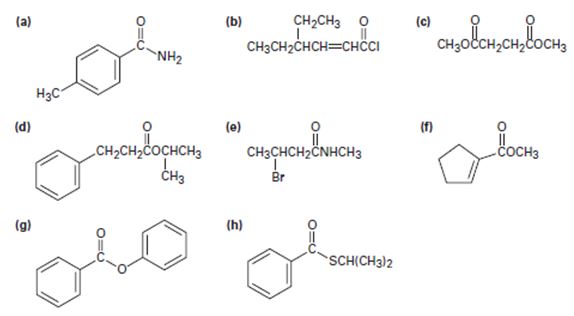
a)
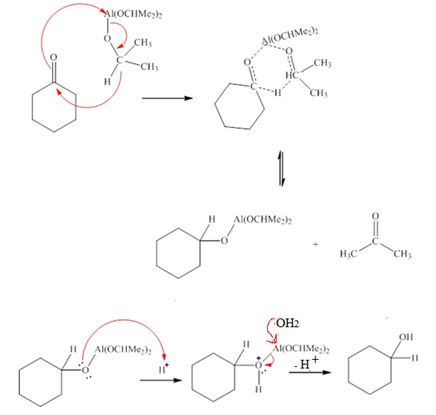
Interpretation:
To identify the given compound by introspecting its structural formula and name it by the IUPAC system.
Answer to Problem 45AP
The IUPAC name of the given compound is p-methyl phenyl acet amide.
Explanation of Solution
The compound given is an unsubstituted amide that can be represented by the general formula  ; since the amide nitrogen in NH2 is not substituted by R1 an alkyl group.
; since the amide nitrogen in NH2 is not substituted by R1 an alkyl group.
The R alkyl group attached to carbonyl carbon is phenyl, which has a para-substituted methyl with the  substituent. ie
substituent. ie
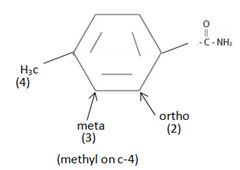
The IUPAC system of naming an amide unsubstituted follows this rule:
Replace the –oic acid or ic acid ending with amide and use the R alkyl group before this. Thus p-methyl-phenyl acetic acid to

Thus the IUPAC name of the given compound is p-methyl phenyl acet amide.
b)

Interpretation:
To identify the given compound by introspecting its structural formula and name it by the IUPAC system.
Answer to Problem 45AP
Thus the IUPAC name of the given compound is 4-ethyl-2-hexenoyl chloride.
Explanation of Solution
The given structure is consistent with  , an acyl chloride.
, an acyl chloride.
The IUPAC system names an acyl chloride by first identifying the alkyl component R by its IUPAC name. [the parent hydro carbon residue]. Obviously this given the name of the parent carboxylic acid itself. Follow this name by replacing the -ic acid ending with oyl and finally add the halide suffix.
For the given compound the parent hydrocarbon R is a six-carbon unsaturated hydrocarbon chain as.
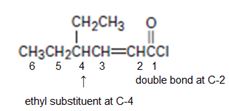
Thus this chain (longest chain) is named 4-ethyl-hexene-(2) [oic - acid] and the halide substituent chloride. We replace –oic acid by –oyl chloride. This leads to 4-ethyl-2 hexenoyl chloride or 4-ethyl-hexene-2-oyl chloride (from 4-ethyl-hexene-2-oic acid or 4 ethyl-2-hexenoic acid). The parent carboxylic acid.
Thus the IUPAC name of the given compound is 4-ethyl-2-hexenoyl chloride.
c)

Interpretation:
To identify the given compound by introspecting its structural formula and name it by the IUPAC system.
Answer to Problem 45AP
The IUPAC name of the given compound is thus dimethyl succinate.
Explanation of Solution
The given compound is

The structural formula A, of the given compound shows it to be the ester derivative of the dicarboxylic acid succinic acid is
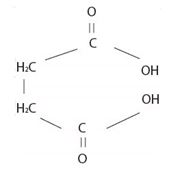
The IUPAC system prescribes the following rule to name an ester derivative of a carboxylic acid thus:
First, identify the two alkyl group attached to each carboxylic oxygen (for two carboxylic acid groups in the given dicarboxylic acid). Then name the ester by starting with the name of their alkyl group (S) and adding the suffix–ate to replace the ending–ic acid.
Thus, combining these two rules, the given ester is named by IUPAC system as dimethyl succinate (from succinic acid) (for two CH3 groups) attached to carboxyl-groups)
The IUPAC name of the given compound is thus dimethyl succinate.
d)
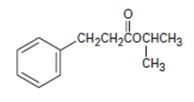
Interpretation:
To identify the given compound by introspecting its structural formula and name it by the IUPAC system.
Answer to Problem 45AP
Thus, the IUPAC isopropyl-3 phenyl pro panoate name of the given compound is isopropyl–3 phenyl propanoate.
Explanation of Solution
The structural formula for the given compound is consistent with the general formula for an ester derivative of a mono carboxylic acid is  for the ester and for the parent acid the IUPAC system prescribes the following rules to name such an ester derivative is:
for the ester and for the parent acid the IUPAC system prescribes the following rules to name such an ester derivative is:
1) First, identify and name the alkyl group R1, attached to the carboxyl oxygen. For the given compound, it is isopropyl

This corner in the prefix, first in the name of the parent carboxylic acid and also in the ester derivative.
2) Second, identify the R alkyl chain residue of the carboxylic acid. This for the given compound is the 3 carbon propanoic acid with a phenyl substituent at C-3 ie

3) Combining these two rules, finally the use the suffix–ate to replace the–ic acid ending. This given.
Thus, the IUPAC isopropyl-3 phenyl pro panoate name of the given compound is isopropyl–3 phenyl propanoate.
e)

Interpretation:
To identify the given compound by introspecting its structural formula and name it by the IUPAC system.
Answer to Problem 45AP
The IUPAC name of the given compound is N-methyl-4 bromo butanamide.
Explanation of Solution
The structural formula given for the compound is
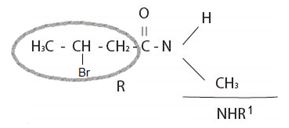
Consistent with the general formula for an amide derivative of a carbonylic acid is  with the amide bring further alkyl, R1, substituted at the amide nitrogen ie NHR1 or
with the amide bring further alkyl, R1, substituted at the amide nitrogen ie NHR1 or  the IUPAC system prescribes the following ruler to name such substituted amides.
the IUPAC system prescribes the following ruler to name such substituted amides.
1) First, identify the N-alkyl substituent. In the given compound it is N-methyl-(mono substituted).
2) Next identify and name by the IUPAC system, the R, ie alkyl hydrocarbon chain component attached to the carbonyl carbon.
For the given compound, R is,

or remembering that carbonyl carbon is C-1, it is four carbon (longest hydro carbon chain) with a bromine at carbon-C-3. Thus, the name of this residue is 4-bromo butan–(derivative).
Finally, combining these two aspects, replace the–ic acid ending for the parent 4-bromobutanoic acid by –amide. This leads to N-methyl-4-bromo butanamide.
Thus the IUPAC name of the given compound is N-methyl-4 bromo butanamide.
f)

Interpretation:
To identify the given compound by introspecting its structural formula and name it by the IUPAC system.
Answer to Problem 45AP
The IUPAC name for the given compound methyl-1-cyclopentene carboxylate.
Explanation of Solution
The IUPAC system prescribes the following rules to name such compounds is:
a) First, identify and name the R1, compound of the ester oxygen OR1. This, in the given compounds is methyl –OCH3.
b) Next identify the parent hydro carbon residue R attached the carbonyl carbon. For the given compound it is an unsaturated cyclopentene (5 carbon closed cyclic hydro carbon) with a double bond at C-1, which holds the carboxyl carbon. ie
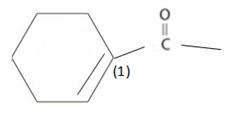
Thus, this residue R is 1-cyclopentene for the parent acid 1-cyclopentene carboxylic acid. Finally, combining these two rules, replace the –ic acid ending by –ate ie carboxylate. Thus, the name of the ester is methyl-1-cycopentene carboxylate.
Thus the IUPAC name for the given compound methyl-1-cyclopentene carboxylate.
g)
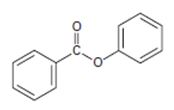
Interpretation:
To identify the given compound by introspecting its structural formula and name it by the IUPAC system.
Answer to Problem 45AP
The IUPAC name of the given compound is phenyl-benzoate.
Explanation of Solution
The IUPAC system prescribes the following rules to name such esters is:
1) First identify and name the alkyl residue R1 of the ester oxygen. This, in the given compound is phenyl Ph or  (unsubstituted)
(unsubstituted)
2) Second, identify and name by the IUPAC system the alkyl residue R attached to carbonyl carbon. This, in the given compound is
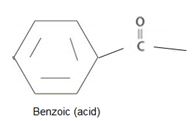
Finally combining these two rules, replace the –ic acid ending with the suffix –ate; the R1 alkyl name is the prefix. This leads to phenyl-benzoate.
Thus, the IUPAC name of the given compound is phenyl-benzoate.
h)

Interpretation:
To identify the given compound by introspecting its structural formula and name it by the IUPAC system.
Answer to Problem 45AP
Thus the IUPAC name for the given compound is isopropyl-phenyl since it is a thio ester carbothioate.
Explanation of Solution
The IUPAC system prescribes the following rules to name such thiol derivatives (sulphur) is:
1) First, identify and name by the IUPAC system, the alkyl residue, R1 attached to the –SR1 function. For the given compound this is the iso-propyl function ie

2) Next, identify and name the alkyl R residue attached to the carbonyl carbon. This is, for the given compound
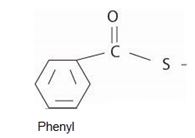
The parent carboxylic acid is thus phenyl carboxylic acid or
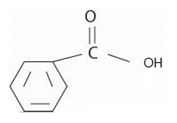
Finally, combining these two aspects, recall that the general ester of this carboxylic acid is the IUPAC name
Phenyl carboxylate for the this ester function, substitute the carboxylate ending by carbothioate. These the IUPAC name is, Isopropyl-phenyl carbothioate.
Thus the IUPAC name for the given compound is isopropyl-phenyl since it is a thio ester carbothioate.
Want to see more full solutions like this?
Chapter 21 Solutions
EBK ORGANIC CHEMISTRY
- In the analysis of Mg content in a 25 mL sample, a titration volume of 5 mL was obtained using 0.01 M EDTA. Calculate the Mg content in the sample if the Ca content is 20 ppmarrow_forwardPredict the organic products that form in the reaction below: H. H+ + OH H+ Y Note: You may assume you have an excess of either reactant if the reaction requires more than one of those molecules to form the products. In the drawing area below, draw the skeletal ("line") structures of the missing organic products X and Y. You may draw the structures in any arrangement that you like, so long as they aren't touching. Explanation Check Click and drag to start drawing a structure. G X C © 2025 McGraw Hill LLC. All Rights Reserved. Terms of Use | Privacy Center | Access +arrow_forward111 Carbonyl Chem Choosing reagants for a Wittig reaction What would be the best choices for the missing reagents 1 and 3 in this synthesis? 1. PPh3 3 1 2 2. n-BuLi • Draw the missing reagents in the drawing area below. You can draw them in any arrangement you like. Do not draw the missing reagent 2. If you draw 1 correctly, we'll know what it is. • Note: if one of your reagents needs to contain a halogen, use bromine. Explanation Check Click and drag to start drawing a structure. × ©2025 McGraw Hill LLC. All Rights Reserved. Terms of Usearrow_forward
- A student proposes the transformation below in one step of an organic synthesis. There may be one or more reactants missing from the left-hand side, but there are no products missing from the right-hand side. There may also be catalysts, small inorganic reagents, and other important reaction conditions missing from the arrow. • Is the student's transformation possible? If not, check the box under the drawing area. . If the student's transformation is possible, then complete the reaction by adding any missing reactants to the left-hand side, and adding required catalysts, inorganic reagents, or other important reaction conditions above and below the arrow. • You do not need to balance the reaction, but be sure every important organic reactant or product is shown. + T X O O лет-ле HO OH HO OH This transformation can't be done in one step.arrow_forwardDetermine the structures of the missing organic molecules in the following reaction: X+H₂O H* H+ Y OH OH Note: Molecules that share the same letter have the exact same structure. In the drawing area below, draw the skeletal ("line") structures of the missing organic molecules X and Y. You may draw the structures in any arrangement that you like, so long as they aren't touching. Click and drag to start drawing a structure. X Sarrow_forwardPredict the major products of this organic reaction. If there aren't any products, because nothing will happen, check the box under the drawing area instead. No reaction. HO. O :☐ + G Na O.H Click and drag to start drawing a structure. XS xs H₂Oarrow_forward
- What are the angles a and b in the actual molecule of which this is a Lewis structure? H H C H- a -H b H Note for advanced students: give the ideal angles, and don't worry about small differences from the ideal groups may have slightly different sizes. a = b = 0 °arrow_forwardWhat are the angles a and b in the actual molecule of which this is a Lewis structure? :0: HCOH a Note for advanced students: give the ideal angles, and don't worry about small differences from the ideal that might be caused by the fact that different electron groups may have slightly different sizes. a = 0 b=0° Sarrow_forwardDetermine the structures of the missing organic molecules in the following reaction: + H₂O +H OH O OH +H OH X Note: Molecules that share the same letter have the exact same structure. In the drawing area below, draw the skeletal ("line") structure of the missing organic molecule X. Click and drag to start drawing a structure.arrow_forward
- Identify the missing organic reactant in the following reaction: x + x O OH H* + ☑- X H+ O O Х Note: This chemical equation only focuses on the important organic molecules in the reaction. Additional inorganic or small-molecule reactants or products (like H₂O) are not shown. In the drawing area below, draw the skeletal ("line") structure of the missing organic reactant X. Click and drag to start drawing a structure. Carrow_forwardCH3O OH OH O hemiacetal O acetal O neither O 0 O hemiacetal acetal neither OH hemiacetal O acetal O neither CH2 O-CH2-CH3 CH3-C-OH O hemiacetal O acetal CH3-CH2-CH2-0-c-O-CH2-CH2-CH3 O neither HO-CH2 ? 000 Ar Barrow_forwardWhat would be the best choices for the missing reagents 1 and 3 in this synthesis? 1. PPh3 2 2. n-BuLi 3 Draw the missing reagents in the drawing area below. You can draw them in any arrangement you like. • Do not draw the missing reagent 2. If you draw 1 correctly, we'll know what it is. • Note: if one of your reagents needs to contain a halogen, use bromine. Explanation Check Click and drag to start drawing a structure.arrow_forward

 General, Organic, and Biological ChemistryChemistryISBN:9781285853918Author:H. Stephen StokerPublisher:Cengage Learning
General, Organic, and Biological ChemistryChemistryISBN:9781285853918Author:H. Stephen StokerPublisher:Cengage Learning Organic And Biological ChemistryChemistryISBN:9781305081079Author:STOKER, H. Stephen (howard Stephen)Publisher:Cengage Learning,
Organic And Biological ChemistryChemistryISBN:9781305081079Author:STOKER, H. Stephen (howard Stephen)Publisher:Cengage Learning, Chemistry for Today: General, Organic, and Bioche...ChemistryISBN:9781305960060Author:Spencer L. Seager, Michael R. Slabaugh, Maren S. HansenPublisher:Cengage Learning
Chemistry for Today: General, Organic, and Bioche...ChemistryISBN:9781305960060Author:Spencer L. Seager, Michael R. Slabaugh, Maren S. HansenPublisher:Cengage Learning Organic ChemistryChemistryISBN:9781305580350Author:William H. Brown, Brent L. Iverson, Eric Anslyn, Christopher S. FootePublisher:Cengage Learning
Organic ChemistryChemistryISBN:9781305580350Author:William H. Brown, Brent L. Iverson, Eric Anslyn, Christopher S. FootePublisher:Cengage Learning




